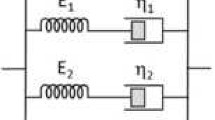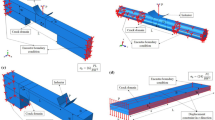Abstract
The usual experimental determination of elastic energy release rates involves the measurement of load-deflection curves of selected specimen configurations with varying crack lengths. The desired energy release rate, ℐ is then related to the rate of change of the slope of this load-deflection curve with respect to the crack length.
The determination of these slopes is sometimes complicated by virtue of nonlinear Hertzian type deformations at pins and holes. To circumvent such nonlinearities, it is customary to employ a reduced gage length. In practice, however, it is frequently desirable to utilize nonsymmetric specimens; in this case, reduced gage lengths cannot be used. Thus, one is forced to accept the nonlinear pin-to-pin measurements with the associated tendency to obscure the validity of the data with respect to the energy release rate determination. A procedure for utilizing these nonlinear curves is suggested and verified experimentally.
Résumé
Pour déterminer expérimentalement les taux de relaxation de l'énergie élastique, on a coutume de mesurer les courbes charges-déplacements d'éprouvettes de géométries adéquates, pourvues de fissures de longueurs variables.
Le taux de relaxation de 1'energie est ensuite mis en relation avec le taux de changement de pente de la courbe déplacement correspondante avec la longueur de fissuration.
II arrive que la détermination de ces pentes soit rendue compliquée par les déformations non linéaires hertziennes qui se produisent cans le système axes-alésages de la mise en charge. De telles non-linéarités peuvent êtres évitées en utilisant une base de mesure de longueur réduite. Toutefois, dans la pratique, il est fréquent de devoir recourir à des éprouvettes non symétriques; sous ces conditions, il ne peut titre fait usage d'une telle base de mesure.
Dès lors, on est biers forcé de se rapporter à des mesures d'axe à axe, dont la non linéarité pent avoir pour conséquence de masquer la validité de l'expérience, lorsque celle-ci vise à la détermination du taux d'énergie relaxée. L'objet de ce mémoire est de suggérer une procédure d'utilisation de ces courbes non linéaires, et d'en démontrer la fiabilité par voie expérimentale.
Zusammenfassung
Zur experimentellen Bestimmung des Relaxationsgrades der elastischen Energie werden gewöhnlich die BelastungsDehnungskurven an mit Rissen verschiedener Länge verschenen Proben passender geometrischer Form gemessen. Anschließend wird der Relaxationsgrad der Energie gegen die Änderung der Steigung der gegebenen Rißlänge entsprechenden Dehnungskurve aufgetragen.
Die Bestimmung dieser Steigungen wird manchmal durch das Auftreten nichtlinearer Hertz'scher Verformungen an den Einspannvorrichtungen gestört. Solche Unlinearitäten können durch Verwendung einer verkürzten Mcßbasis vermieden werden. In der Praxis ist es jedoch Mufig erfordert unsymmetrische Proben zu verwenden; hier ist die Anwendung einer solchen McBbasis dann nicht mehr möglich.
Deshalb ist man gezwungen sich auf die unlinearen Messungen von Achse zu Achse zu stützen, wobei die Gültigkeit des Versuchs in Frage gestellt werden kann, falls es sich um die Bestimmung des Energie-Relaxationsgrades handelt. Es wird ein Verfahren zur Auswertung solcher nichtlinearer Kurven angegeben and seine Fiabilität wird experimentell bewiesen.
Similar content being viewed by others
Abbreviations
- a :
-
Crack or slot length, inches
- cmacr:
-
Compliance, deflection per unit load per unit thickness, cmacr =y/(P/t) = y/Pmacr
- E :
-
Young's Modulus, psi
- L :
-
Length of specimen, in.
- ℐ:
-
Elastic energy release rate, in.-lb./sq. in.
- K :
-
Stress intensity factor, psi (in.)1/2
- K/σ/a :
-
Dimensionless stress intensity factor ratio
- P :
-
Load, lb.
- Pmacr:
-
Load per unit thickness, lbs./in.
- σ:
-
Uniform stress applied to ends of specimen, psi
- t :
-
Thickness, in.
- W :
-
Work, in.-lb.
- w :
-
Width of specimen, in.
- a/w :
-
Crack length to specimen width ratio
- y :
-
Deflection, inches, either pin-to-pin or head-to-head, see Fig. 1
References
J. I. Bluhm, The Effect of Nonlinear Hertzian Deformations and Gage Length on the Measurement of Elastic Energy Release Rate, J. of Materials, 2, 1 (1967) 227–236.
J. E. Srawley, M. H. Jones and B. Gross, Experimental Determination of the Dependence of Crack Extension Force on Crack Length for a Single-Edge-Notch Tension Specimen, NASA TN D-2396, August 1964.
W. T. Koiter, On the Flexural Rigidity of a Beam Weakened by Transverse Saw Cuts, Proc. Kom. Ned. Ak. Wet. Amsterdam, B, 59 (1956); also, J. of Applied Mechanics (1965).
O. L. Bowie and D. M. Neal, The Effective Crack Length of an Edge Slot in a Semi-Infinite Sheet Under Tension, International J. of Fracture Mechanics, 3, 2 (1967) 111–119.
J. M. Bloom, The Short Single Edge Crack Specimen with Linearly Varying End Displacements, International J. of Fracture Mechanics, 2, 4 (1966) 597–603.
J. M. Bloom, Errata on The Short Single Edge Crack Specimen with Linearly Varying End Displacements, International J. of Fracture Mechanics, 3 (1967) 235–236.
Author information
Authors and Affiliations
Rights and permissions
About this article
Cite this article
Baratta, F.I., Bluhm, J.I., Driscoll, G.W. et al. Elastic energy release rates determined from nonlinear load-deflection curves. Int J Fract 7, 203–213 (1971). https://doi.org/10.1007/BF00183807
Received:
Revised:
Issue Date:
DOI: https://doi.org/10.1007/BF00183807




